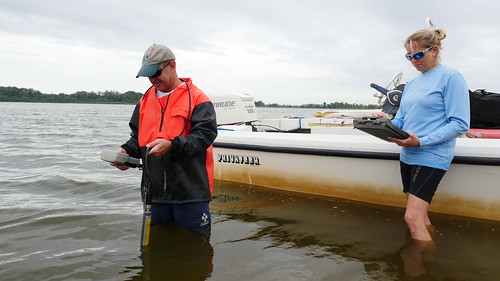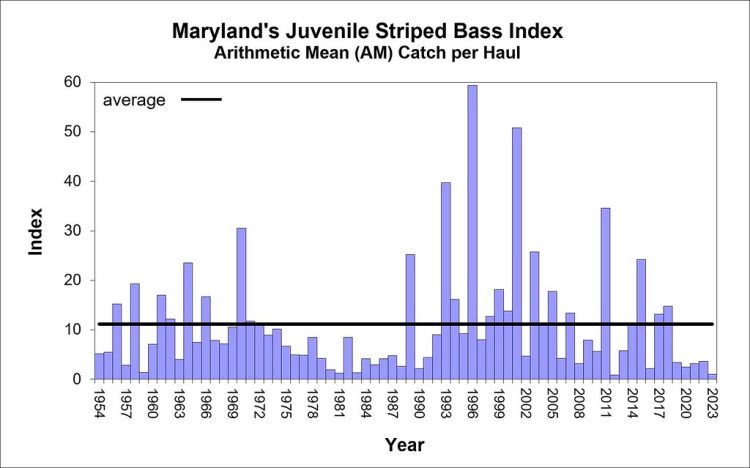Chesapeake Striped Bass Reproduction Lowest in 10 Years

The numbers are in from the 2023 Maryland Department of Natural Resources Young-of-Year Striper Survey, and not only is it the fifth consecutive below-average spawn, it’s the worst spawn since 2012.
Weather and river conditions during the winter and early spring play a major role in the spawning success of striped bass and other anadromous species. With a mild, dry winter this year, the river conditions weren’t conducive to spawning, and striped bass, along with white perch, yellow perch, and herring, recorded below-average spawns.

DNR Fisheries and Boating Director Lynn Fegley said, “It’s important to remember that increasing the size of the striped bass stock does not guarantee strong reproduction. We will continue to work with other coastal states to rebuild the population so spawning can succeed when conditions are right.”
While there’s nothing we, as anglers, can do about the poor striped bass recruitment since 2019, we can help protect the fish we have. Proper catch and release practices will help our current stock of striped bass to survive and grow, so that when spawning conditions are right, the fish will be there.
From the DNR Press Release on the Survey Results: “Previously, favorable environmental conditions for striped bass such as heavy winter snowfalls or higher spring rainfalls have helped produce stronger juvenile year classes. Nutrient pollution reduction efforts throughout the Bay watershed have also reduced the instances of hypoxia affecting striped bass and other fish.”
Here’s to hoping the Farmer’s Almanac prediction of a cold, snowy winter this year are correct.

How do Warm Winters affect the Striped Bass spawn?
Striped bass spawning activity is temperature-driven and historically adult fish migrated to the Chesapeake Bay to spawn in April and May, which aligned with the seasonal arrival of zooplankton and other microscopic food sources that larval striped bass eat. However, recent winters have produced less-than-average snowfalls in the region and therefore less snowmelt to cool the rivers and streams where striped bass spawn.
Research has also shown Spring zooplankton production in the Bay is being altered by warmer winters. Fishery scientists are continuing to investigate whether higher temperatures earlier in the year are affecting the survivability of juvenile striped bass.
How Does Maryland DNR Measure the Success of a Striped Bass Spawn?
The juvenile striped bass survey documents annual year-class success for young-of-the-year striped bass and relative abundance of many other fish species in Chesapeake Bay. Annual indices of relative abundance provide an early indicator of future adult stock recruitment and document annual variation and long-term trends in abundance and distribution. Every year, fishery managers examine 22 sites located in four major striped bass spawning areas: the Choptank, Nanticoke, and Potomac rivers, and the Upper Chesapeake Bay. Biologists visit each site three times per summer, collecting fish with two sweeps of a 100-foot beach seine net. The index represents the average number of recently hatched striped bass captured in each sample. This produces a total of 132 samples from which bay-wide means are calculated.
2023 Young-of-Year Survey Highlights
Biologists captured more than 47,000 fish of 63 different species while conducting this year’s survey. Encouraging results were documented regarding two species lower on the food chain. Menhaden abundance was the highest measured in over 30 years. Bay anchovy abundance was the highest measured since 1974. These species are very important to the ecology of the Bay as a food source for many other species of fish and wildlife.
20 on “Chesapeake Striped Bass Reproduction Lowest in 10 Years”
-
Vince Due to Global Warming fish are taking residents in areas up north as far as Brunswick, Canada. Who’s studying that as an aggregation of sustainability of theStriped Bass fishery. As a fisherman, ironically enough striped bass fishing has been its best in 10 years.
-
SomeoneWithABrain Vince, you’re completely incorrect. The Canadian fish are genetically an entirely different stock – and that population is booming because they had a decade long moratorium. Sorry, but your agenda doesn’t fit here. Atlantic striped bass are in big trouble.
-
Vince Sounds like Fake News to me. Fishing has been great and the faux research does not reflect that Fishing in America is Great Again! (FAGA) Are there any research being done with holdovers in the Sakonett, Providence River, Thames River, Hudson River? Those fish are NOT migrating to the Cheasepeake. Why are there no research money in that? Stop crying the sky is falling. That’s the problem with Liberals nowadays and their tree hugging policies. Believe in GOD!
-
-
-
Carl Sounds like we should stop the harvest of stripers, so we can preserve what we have. Gamefish status!
-
Cape I agree!!!!!! make Srriped Bass a Game Fish.
Shut it down commercially and recreational as well. For 5 to 8 yrs at least.
-
-
Mike So 6 people dragged a seine net in the chesapeake for a couple days and think they know the spawning success of 20 million fish coast wide . thanks, great article LOL
-
Aaron I would love to see an OTW “How to handle your catch” video series for the best catch and release practices based on the most current science for some of the popular game fish, fresh and salt. Stripers, tog, alblies, Large/small mouth bass, pike, trout. It would pair really well the Protect What You Love program you have going.
-
Jake Jergens Time to give some pain to the commercial fishery since they basically are the ones killing all the breeders since the rec slot doesn’t allow the taking of breeding fish.
Game fish status, as noted above, would correct the issue.
Poachers are going to poach so tougher enforcement needed as well.
Of course, none of this will happen since the fisheries industry is corrupt, just like everything else in this country.
-
Dr. Steve S Hey Mike,
I’ve been watching the YOY Index for over 25years and its’ correlation with what our fishery looks like is indeed variable. However, it is sensible to compare it with previous years and really consider low juvenile counts(imperfect as they may be) as our best predictor of what lies ahead for the bass population. Don’t knock the tracking data; it’s the best we have.
Steve -
Bass1 And yet MA continues to allow the slaughter of the brood stock for commercial purposes.🤯
-
Rk The biggest cause of mortality of stripers is recreational fishermen, not commercial fishermen. That is so well documented at this point that everyone with knives out for the commercial guys have to be held suspect. The death count from keeping stripers and from dead discards of recreational fishing is several times more than the number of fish the commercial guys take.
And I say this as a rec fisherman,
Sorry, but ending commercial bass fishing harvest will not create wall to wall stripers and will not allow you to catch fifty pounders in a 3 foot deep tidal creek on a soft plastic shad or a Clouser so you can brag to your friends. Big fish live in big fish places, require big fish tactics, and banning all the people you don’t like from the resource will not change that.
The solution requires that everyone compromises, not just one part of the fishery. And that amateur anglers have realistic expectations about what kind of fish their tactics are likely to catch,
-
Bass1 Having personally seen fish box after fish box of breeders stacked up it obvious that these fish are dead and are all 35” or larger. So to say recreational fishing is the problem doesn’t hold water as none of us in MA are allowed to keep stripers this size.
-
Scott Or stop letting idiots catch and release the spawning females in the Susquehanna river. We don’t go out and drag pregnant women down the street, so why do it to a fish that is in need of reproductive help.
-
-
Matterhorn55844 Sounds like alot of Leftist fear mongering propaganda if you ask me. Blaming global warming for everything is a Democrat talking point, Sad that OTW has turned into CNN
-
FairPoint Does OTW not have any monitoring of the comment section? I’m all for free speech but “Vince” is not a rational contributor to an important discussion.
-
Mike Is the study perfect? Probably not, but it’s the best we have. If we just ignore all of this stuff then the outcome is guaranteed. Why do people think everything is a conspiracy?
-
Bob I think you need more people in the field to correctly see the numbers of fish over the last couple of years The numbers of small fish in December has increased substantially and I really don’t know we’re this data come from. You should take a survey in New Jersey and then tell me about your survey. Looks like the Hudson River stock is doing pretty good
-
Matterhorn55844 Congrats OTW you’ve officially become CNN of fishing, and Bob you bring up a great point
-
Vincent D Higgins The commercial, rec, and charter fleet must share the pain. The spawning stock in the Susquehanna need to be left alone as eliminating the trophy season. If you talk to the charter fleet they will tell you the trophy season is not a big income producer for them. I have fished the Chesapeake Bay for 52 years, went through the shut down, One problem is DNR has been allocated funds to study the problem, but they either do not spend the money given or institute studys that do not address the underlying problems. Lets do what’s good for the species, not politics or one special interest group with deep pockets.
-
paul cuzzupe what would happen if hunters killed more does than bucks in the deer population? “problem with common sense is its not very common”
Leave a Reply